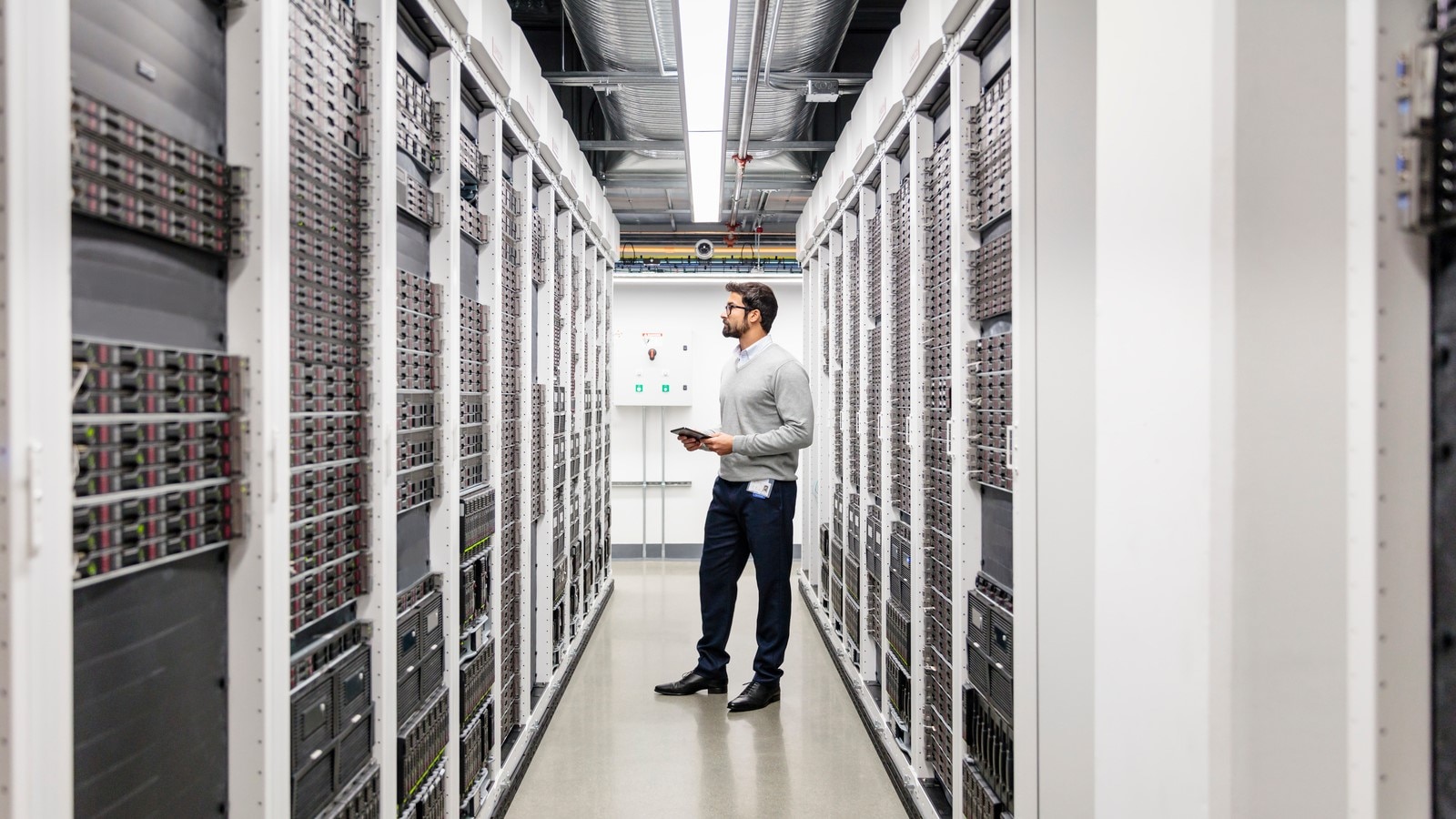
On-Premises Data Centers vs. Cloud Computing What is On-Premises Data Centers vs. Cloud Computing?
An on-premises data center is a group of servers you privately own and control. Traditional cloud computing (as opposed to hybrid or private cloud computing models) involves leasing data center resources from a third-party service provider. On-premises data centers, commonly called “on-prem,” allow you to gain full control of your infrastructure, while cloud computing is cost-efficient and easy to scale.

- On-premises data center definition
- Cloud computing definition
- Private cloud computing definition
- Benefits and Drawbacks of On-Premises Computing
- Benefits and Drawbacks of Cloud Computing
- On-prem and cloud compared
- HPE products and solutions for on premises vs cloud
What is on-premises data center?
"On-prem" refers to private data centers that companies house in their own facilities and maintain themselves. On-prem infrastructure can be used to run private clouds, in which compute resources are virtualized in much the same way as those of public clouds (however, private clouds can also be run on leased third-party hardware).
What is cloud computing?
When people speak of cloud computing, they’re most often referring to "traditional," or "public," cloud, a model in which a third-party service provider makes computing resources available for consumption on an as-needed basis. Public cloud is a multi-tenant environment, meaning that these computing resources are shared by multiple individuals or companies, with all data secured by state-of-the-art encryption.
What is private cloud computing?
Private cloud computing is a system dedicated solely to one enterprise. It integrates cloud computing scalability, resource pooling, and self-service capabilities into the organization's infrastructure. Private clouds provide greater control, security, and customization than public clouds. They can be hosted on-site or accessed via third-party services. Enterprises and organizations with strict data privacy and regulatory compliance requirements prefer private cloud environments for using cloud technology while keeping infrastructure and data control.
What are the benefits and drawbacks of on-premises computing?
A. Advantages of computing on-site:
- Controlling and protecting data in on-site setups: On-premises setups let companies handle their data and security steps directly. This can be especially important for businesses that must follow strict rules or take private data. By having their data in their own physical surroundings, organizations can put in place and adjust security measures to their exact needs.
- Predictable Performance and Low-Latency Access to Data: With on-premises technology, businesses have direct control over hardware and network settings, which makes performance predictable.
- Customizable and Flexible On-Premises Infrastructure: Organizations can change their on-premises architecture to fit their needs. This includes choosing hardware components, networking gear, and software solutions that meet their needs. This level of personalization can help improve speed and better use of resources.
B. Drawbacks of On-Premises Computing:
- High initial costs and capital expenses: Setting up a system on-premises requires a lot of money upfront. Organizations must spend money on tools, networking equipment, and other systems parts. This investment can be expensive, especially for small enterprises or businesses with limited funds.
- Limited scale and the possibility of overprovisioning: On-premises setups may have trouble scaling significantly when resource demand increases quickly. Organizations must correctly predict what they will need in the future. If they overestimate, they may have more resources than they need; if they underestimate, they may run into performance problems.
- IT management and maintenance complexities: On-premises equipment must be managed and maintained constantly. This means keeping the hardware in excellent condition, updating the software, adding security patches, and fixing problems. Organizations need skilled IT staff to handle these jobs, which can add to business costs and resource use.
What are the benefits and drawbacks of cloud computing?
A. Advantages of Cloud Computing:
- Cost-Effectiveness and Flexible Pricing: Cloud computing offers an intelligent way to manage costs, as you only pay for what you use. This eliminates the need for significant upfront investments in hardware. The pay-as-you-go model allows for flexible resource scaling to manage expenses.
- Easy Scaling and Adaptability: The cloud's scalability is a game-changer. You can quickly adjust your resources to match demand, avoiding wasteful overprovisioning. This flexibility is beneficial during busy times or growth spurts.
- Global Access and Collaboration: Cloud services are accessible from anywhere with an internet connection. This opens up opportunities for remote work and seamless collaboration across different locations, supporting modern business methods.
B. Drawbacks of Cloud Computing:
- Security and Privacy Considerations: Entrusting sensitive data to the cloud raises valid security and privacy concerns. While cloud providers have strong security measures, you still need to place confidence in them. Adhering to industry standards and regulations is vital to manage these risks.
- Reliance on Internet Connectivity and Downtime Risk: Cloud services rely on Internet access. Operations can halt if your connection goes down or the cloud provider experiences an outage. This underscores the importance of backup plans and ensuring continuous access.
- Navigating Compliance in a Global Context: Data hosted in the cloud might be subject to the laws of the countries where the cloud provider operates. This can lead to complexities, especially if data spans various regions with differing legal requirements.
Deciding between managing your infrastructure and embracing cloud solutions is about finding the best fit for your needs. Some companies opt for a mix of both approaches, benefiting from the cloud's agility while addressing concerns through hybrid strategies. By understanding the benefits and challenges of on-premises and cloud computing, you can make well-informed choices aligned with your goals and resources.
What is the difference between on-prem and cloud?
Both on-prem and cloud computing can provide your business with the IT infrastructure it needs. The model you choose will likely depend on the level of security you need in order to meet compliance standards and on the cost structure you prefer. Here’s a look at how the two models compare.
Business need: Data center single tenancy (for compliance)
- On-premises: ✔ Public Cloud: X
Business need: Highly secure data encryption
- On-premises: ✔ Public Cloud: ✔
Business need: Customizable hardware, purpose-built systems
- On-premises: ✔ Public Cloud: X
Business need: Capacity easy to scale up and down
- On-premises: X Public Cloud: ✔
Business need: Infrastructure requires large, regular investments
- On-premises: ✔ Public Cloud: X
Business need: Pay-as-you-go, usage-based pricing
- On-premises: X Public Cloud: ✔
Business need: Complete data visibility and control
- On-premises: ✔ Public Cloud: X
Business need: Built-in, automated data backups and recovery
- On-premises: X Public Cloud: ✔
Business need: Near-zero downtime risk
- On-premises: X Public Cloud: X
What are the HPE IT infrastructure management solutions for on-premises and cloud?
Hewlett Packard Enterprise (HPE) offers a range of IT infrastructure management solutions to meet different needs.
- HPE On-premises vs Cloud: This comparison involves comparing on-premises infrastructure with cloud solutions. Hosting and managing your IT infrastructure in-house gives you full control and security but requires upfront capital commitment and continuous maintenance. Cloud solutions offer flexible access to IT resources via the internet but can also pose data privacy and security risks.
- HPE GreenLake for Private Cloud Enterprise: HPE's GreenLake cloud services offer pay-per-use IT infrastructure and services with on-premises management and protection. GreenLake for Private Cloud Enterprise provides a fully managed private cloud environment in the customer's data center for large enterprises.
- HPE GreenLake for Private Cloud Business Edition: It provides a simplified and cost-effective solution for a customer managed private cloud, with flexible payment options based on actual usage.
- HPE GreenLake: GreenLake is an overarching brand for HPE's hybrid cloud platform and its flexible consumption-based IT services. It covers infrastructure, workloads, and applications, providing cloud-like agility and economics with on-premises IT security and performance.
- HPE Hybrid Cloud: HPE integrates on-premises infrastructure with public and private clouds into a seamless ecosystem. HPE technologies and solutions enable hybrid cloud deployments, letting enterprises use the benefits of on-premises and cloud environments as a single infrastructure.
HPE offers a variety of IT infrastructure management solutions, from on-premises solutions to flexible consumption-based hybrid cloud services adapted to diverse business sizes and demands.
